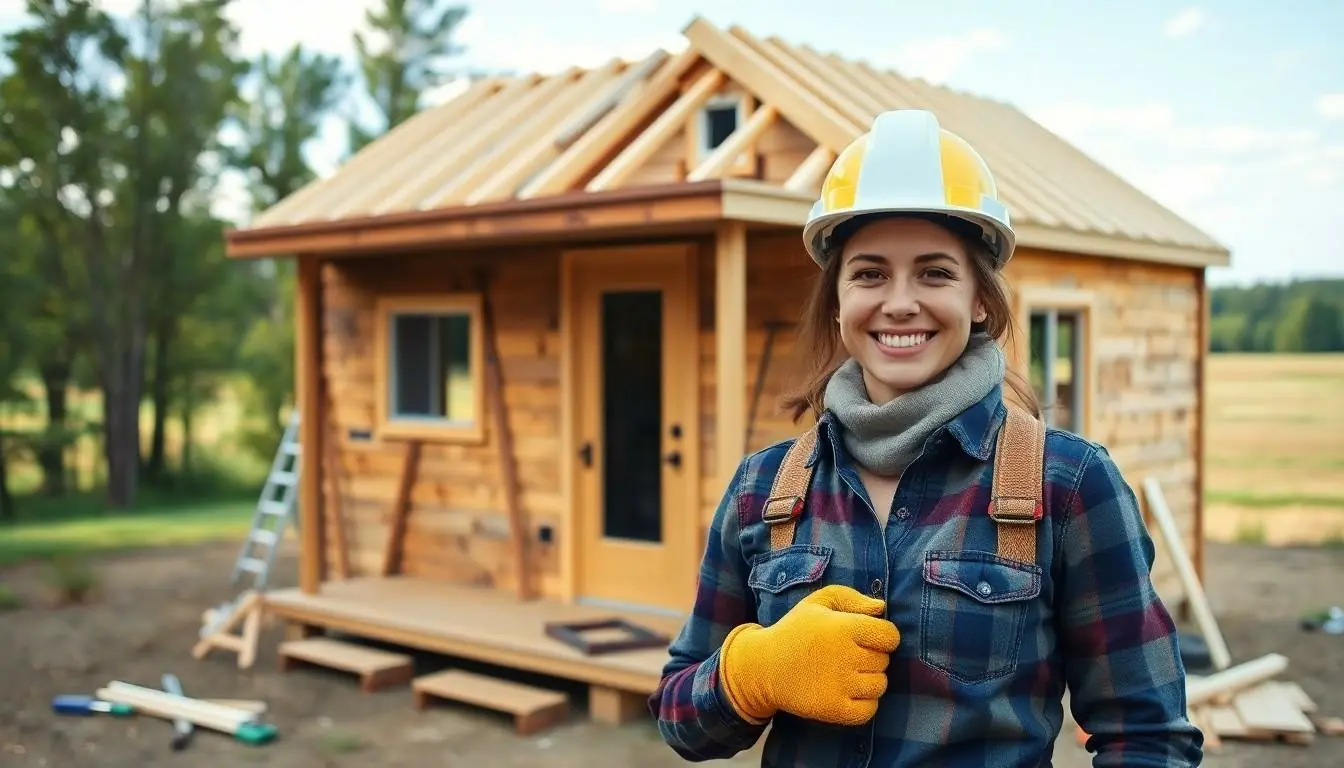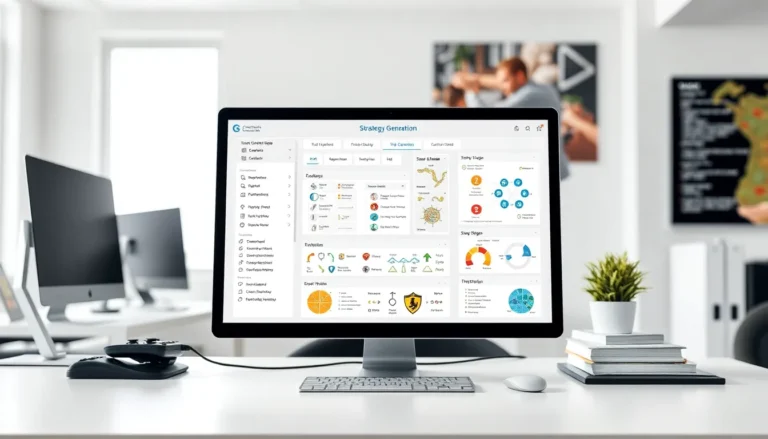Imagine living large in a space that’s smaller than your average parking spot. Welcome to the world of DIY tiny homes, where creativity and resourcefulness reign supreme. These pint-sized abodes offer a unique blend of freedom and fun, allowing anyone to embrace minimalism without sacrificing style. Who knew downsizing could be this exciting?
Table of Contents
ToggleUnderstanding The DIY Tiny Home Movement
Many people turn to DIY tiny homes as a way to embrace a minimalist lifestyle. Options for these homes include mobile structures and stationary designs, providing flexibility based on personal needs. Individuals often find satisfaction in constructing their own spaces, adding personal touches along the way.
The movement promotes financial freedom through reduced housing costs. Statistics indicate that building a tiny home can be significantly cheaper than purchasing a traditional property. Many DIY tiny home builders cite average costs between $10,000 and $50,000 depending on size and materials.
Community engagement plays a crucial role in the DIY tiny home movement. Numerous online forums and social media groups offer resources, sharing construction tips and design ideas among enthusiasts. Workshops and meet-ups also provide opportunities for learning from experienced builders.
Additionally, environmental sustainability drives interest in tiny homes. Smaller spaces require fewer resources, making them an eco-friendly option. Many choose to incorporate energy-efficient appliances and renewable energy sources, further enhancing their environmental impact.
Flexibility also defines the DIY tiny home lifestyle. Some people travel while others settle on residential land. With zoning laws and regulations varying by location, they must conduct thorough research to ensure their plans comply with local rules.
This movement reflects a growing desire for alternatives to conventional living, allowing individuals to live more intentionally. Prioritizing what truly matters can foster satisfaction and creativity in daily life.
Benefits Of Building A DIY Tiny Home

Building a DIY tiny home offers numerous advantages, attracting individuals seeking a unique lifestyle. Among these benefits, cost-effectiveness and environmental impact stand out.
Cost-Effectiveness
Tiny homes provide significant savings in building expenses. Constructing a tiny home typically costs between $10,000 and $50,000, often much lower than traditional properties. Reduced material requirements make it easier to stay within budget. Lower utility bills come with smaller living spaces, enhancing long-term savings. In addition to these savings, tiny homeowners can avoid high mortgage payments. The flexibility of designing their own homes allows builders to choose affordable materials and finishes.
Environmental Impact
Building a tiny home significantly reduces one’s ecological footprint. Smaller structures consume fewer resources during construction. Energy-efficient appliances often accompany tiny homes, promoting sustainable living. Many designs incorporate renewable energy sources, such as solar panels. Waste reduction also plays a critical role, with fewer materials used for construction and daily living. Minimalism leads to intentional consumption, encouraging individuals to prioritize essentials over excess. Evolving lifestyle trends focus on sustainability further enhance the appeal of tiny homes.
Key Considerations Before Starting Your DIY Tiny Home
Embarking on a DIY tiny home project requires careful planning and consideration. Various factors influence the success of this venture.
Zoning and Regulations
Understanding local zoning laws is crucial before starting construction. Regulations can dictate home size, placement, and whether the home can be mobile or stationary. Checking with local authorities provides clarity on permits needed for building. Guidelines may vary widely, making this step essential for compliance and to avoid costly fines. Tiny home builders often face challenges related to land use, so researching those restrictions upfront aids in planning effectively.
Design and Space Planning
Effective design maximizes limited space in a tiny home. Prioritize functionality by incorporating multi-purpose furniture to optimize living areas. Utilize vertical space for storage solutions like shelves or cabinets, ensuring essentials remain accessible. Streamlined layouts enhance comfort and utility, making small spaces feel welcoming. Thoughtful planning helps create a harmonious flow, which enhances both aesthetic and functional elements within the home. Investing time in a detailed design process contributes to a more satisfying living experience in a compact environment.
Essential Tools And Materials
Building a DIY tiny home requires specific tools and materials for success. Essential tools include a circular saw for cutting wood, a drill for making holes, and a level for ensuring structures are straight. Safety gear such as safety glasses and gloves is crucial to protect against accidents.
Materials play a significant role in the construction process. Plywood serves as a foundational component for walls and floors. Insulation, whether fiberglass or foam, provides essential temperature regulation. For roofing, metal sheets or shingles offer durability against the elements.
Additionally, nails and screws secure components together, ensuring structural integrity. It’s vital to choose quality hardware to enhance the home’s longevity. Incorporating eco-friendly alternatives like reclaimed wood or sustainable materials can reduce the environmental impact of the build.
Power tools streamline construction, so investing in an electric sander improves finishing touches on surfaces. A tape measure ensures accuracy during measurements, minimizing material waste. For outdoor work, a portable generator can provide necessary power in remote locations.
Hammers and wrenches are fundamental hand tools for any DIY project. These tools facilitate straightforward assembly and adjustments during the construction phase. Assembling a toolkit with these essentials enables builders to tackle various tasks with confidence.
Organizing materials ahead of time boosts efficiency. Stocking items like paint, caulk, and weatherproofing products can save time later in the process. Ultimately, gathering the right tools and materials lays a solid foundation for a successful DIY tiny home project.
Tips For A Successful DIY Tiny Home Project
Understanding local zoning laws and regulations is vital before starting a DIY tiny home project. Knowledge of home size restrictions, placement, and mobility rules prevents costly misunderstandings later. Checking with local authorities can clarify necessary permits and keep builders compliant.
Designing an efficient layout maximizes the limited space available. Utilizing multi-purpose furniture creates flexibility, while vertical storage solutions increases utility. Builders can invest time in planning to enhance comfort and minimize clutter.
Selecting the right tools and materials ensures a smooth construction process. Key tools like a circular saw, drill, and level are essential. Prioritizing safety with goggles and gloves protects builders during the project. Choosing quality materials such as plywood, proper insulation, and durable roofing options contributes to the home’s longevity.
Incorporating eco-friendly materials aligns with sustainability goals. Using efficient appliances and renewable energy sources reduces the environmental footprint. Eco-conscious choices resonate with the principles of the tiny home movement, creating a harmony between living space and the natural world.
Organizing tools and materials before starting the build improves overall efficiency. Grouping items by use streamlines the construction process, facilitating a clear workflow. Establishing a checklist helps ensure all necessary items are accounted for before diving into the project.
Connecting with the DIY community can provide invaluable support and resources. Participating in online forums and social media groups fosters relationships with other builders. Sharing experiences enhances learning opportunities and broadens understanding of various building techniques.
Embracing the DIY tiny home movement opens doors to a lifestyle defined by freedom and creativity. Individuals can enjoy the thrill of minimalism while crafting a space that reflects their personal style. With financial savings and reduced environmental impact, tiny homes align with the values of sustainability and intentional living.
The journey of building a tiny home is not just about construction; it’s about fostering community connections and sharing experiences. As more people explore this innovative approach to living, they discover the joys of simplicity and the satisfaction of creating a unique home. The DIY tiny home trend represents a shift towards a more fulfilling and mindful way of life.



